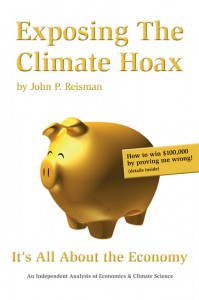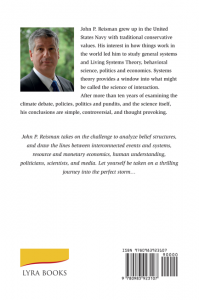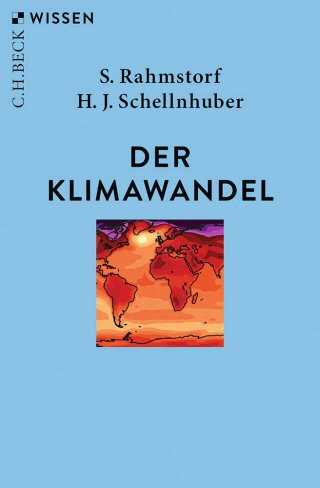Books
Understanding science and economics are key to our standards of living. Understanding why is key to the relative health of our future in relation to our socioeconomic reality. These are only a few books, but they are important in that these books deal with one of the largest and most perplexing issues we now face. It is intertwined with national security and food. It is an exacerbating factor in relation to other dangers including terrorism, food and water security, and even the cohesion of governments.
Exposing The Climate Hoax: It’s ALL About The Economy
by John P. Reisman
What are the facts about the global warming hoax? Climate change happens all the time. Is current change natural or influenced by humans? The answer may not be what you think. Reisman exposes that the hoax is itself a hoax. No matter what you think now, this book provides insights into how the truth has been obscured by the fog of politics and clever distractions. Take a thrilling journey into the perfect storm of politics, perspective, security, economics, psychology and science in “Exposing the Climate Hoax.”
Don’t be ‘tricked’ by the title. Current climate change is real and human caused. This book is an honest and clear look at the ‘real’ hoax, which is that any claim that current global warming is ‘hoax’ is itself a hoax. Climate change is happening and we need to understand what it means to our economy because that translates directly to what it means to our standards of living.
http://www.amazon.com/Exposing-The-Climate-Hoax-Economy/dp/0983923108/
 |
 |
The Discover of Global Warming
Source “The Discovery of Global Warming” by Spencer Weart
Purchase the Book on Amazon.com
From RealClimate.org
This post is a list of books since 2005 (in reverse chronological order) that we have been involved in, accompanied by the publisher’s official description, and some comments of independent reviewers of the work. We will try and keep this list up to date as and when new books appear. We have also added links to the sidebar with the latest offerings.
Available now:
- Climate Change: Picturing the Science. Gavin Schmidt and Joshua Wolfe, W.W. Norton (2009)
- The Long Thaw: How Humans are Changing the Next 100,000 Years of Earth’s Climate. David Archer, Princeton University Press (2009)
- Dire Predictions: Understanding Global Warming Michael Mann and Lee Kump, DK/Pearson (2008)
- Wie bedroht sind die Ozeane? Stefan Rahmstorf and K. Richardson (2007, in German; English version forthcoming fall 2008)
- Global warming: Understanding the Forecast, David Archer (2006)
- Der Klimawandel Diagnose, Prognose, Therapie, Stefan Rahmstorf and H. J. Schellnhuber (2006, in German, Korean, Vietnamese; Arabic version forthcoming)
- Solar Activity and Earth’s Climate, Rasmus Benestad (2006, 2nd Edition)
- Paleoclimatology: Reconstructing Climates of the Quaternary, Ray Bradley (2005, 2nd Edition)
Upcoming:
- Understanding Climate Change: The Unofficial Guide to the IPCC Fourth Scientific Assessment. David Archer and Stefan Rahmstorf, Cambridge University Press, 2009.
- Principles of Planetary Climate, Ray Pierrehumbert. (Cambridge University Press, 2010) (Online draft version)
Happy Reading!
 Paleoclimatology: Reconstructing Climates of the Quaternary, Ray Bradley, (Academic Press, 2nd edition, 2005, originally published in 1999).
Paleoclimatology: Reconstructing Climates of the Quaternary, Ray Bradley, (Academic Press, 2nd edition, 2005, originally published in 1999).
Publisher’s description:
Raymond S. Bradley provides his readers with a comprehensive and up-to-date review of all of the important methods used in paleoclimatic reconstruction, dating and paleoclimate modeling. Two comprehensive chapters on dating methods provide the foundation for all paleoclimatic studies and are followed by up-to-date coverage of ice core research, continental geological and biological records, pollen analysis, radiocarbon dating, tree rings and historical records. New methods using alkenones in marine sediments and coral studies are also described. Paleoclimatology, Second Edition, is an essential textbook for advanced undergraduate and postgraduate students studying climatology, paleoclimatology and paleoceanography worldwide, as well as a valuable reference for lecturers and researchers, appealing to archaeologists and scientists interested in environmental change.
Independent Reviews:
Paleoclimatology is a definite “must-have” for anyone working in climate studies and highly recommended for anyone seriously interested in our climate.
William R. Green, The Leading Edge
This thorough, well referenced text will prove to be indispensable to anyone involved in the study of past and current climate change and modeling.
Southeastern Naturalist
 The Long Thaw:
The Long Thaw:
How Humans are Changing the Next 100,000 Years of Earth’s Climate, David Archer (Princeton University Press, 2009).
Publisher’s description:
If you think that global warming means slightly hotter weather and a modest rise in sea levels that will persist only so long as fossil fuels hold out (or until we decide to stop burning them), think again. In The Long Thaw, David Archer, one of the world’s leading climatologists, predicts that if we continue to emit carbon dioxide we may eventually cancel the next ice age and raise the oceans by 50 meters. By comparing the global warming projection for the next century to natural climate changes of the distant past, and then looking into the future far beyond the usual scientific and political horizon of the year 2100, Archer reveals the hard truths of the long-term climate forecast.
Archer shows how just a few centuries of fossil-fuel use will cause not only a climate storm that will last a few hundred years, but dramatic climate changes that will last thousands. Carbon dioxide emitted today will be a problem for millennia. For the first time, humans have become major players in shaping the long-term climate. In fact, a planetwide thaw driven by humans has already begun. But despite the seriousness of the situation, Archer argues that it is still not too late to avert dangerous climate change–if humans can find a way to cooperate as never before.
Revealing why carbon dioxide may be an even worse gamble in the long run than in the short, this compelling and critically important book brings the best long-term climate science to a general audience for the first time.
Reviews:
In this short book, David Archer gives us the latest on climate change research, and skillfully tells the climate story that he helped to discover: generations beyond our grandchildren’s grandchildren will inherit atmospheric changes and an altered climate as a result of our current decisions about fossil-fuel burning. Not only are massive climate changes coming if we humans continue on our current path, but many of these changes will last for millennia. To make predictions about the future, we rely on research into the deep past, and Archer is at the forefront of this field: paleoclimatology. This is the book for anyone who wishes to really understand what cutting-edge science tells us about the effects we are having, and will have, on our future climate.
Richard B. Alley, Penn State University
This is the best book about carbon dioxide and climate change that I have read. David Archer knows what he is talking about
James Hansen, NASA
Books on climate change tend to focus on what is expected to happen this century, which will certainly be large, but they often neglect the even larger changes expected to take place over many centuries. The Long Thaw looks at climate effects beyond the twenty-first century, and its focus on the long-term carbon cycle, rather than just climate change, is unique.
Jeffrey T. Kiehl, NCAR
A great book. What sets it apart is that it expands the discussion of the impacts of global warming beyond the next century and convincingly describes the effects that are projected for the next few thousand years. What also sets it apart is how deeply it takes general readers into the scientific issues of global warming by using straightforward explanations of often complex ideas.
Peter J. Fawcett, University of New Mexico
 Global warming: Understanding the Forecast
Global warming: Understanding the Forecast
David Archer (Wiley-Blackwell, 2006).
Publisher’s description:
Global Warming: Understanding the Forecast is a comprehensive introduction to all aspects of global warming. Written in an accessible way, this important book examines the processes of climate change and climate stability, from the distant past to the distant future. Examining the greenhouse effect, the carbon cycle, and what the future may hold for global climate, this text draws from a wide range of disciplines, and not only summarizes scientific evidence, but also economic and policy issues, related to global warming. A companion website provides access to interactive computer models of the physics and chemistry behind the global warming forecast, which can be used to support suggested student projects included at the end of each chapter. Global Warming: Understanding the Forecast provides an essential introduction to this vital issue for both students and general readers, with or without a science background.
Independent reviews:
Rigorous but rewarding, David Archer’s book takes us through the science of global warming so that we can more effectively assess where the world may be heading.
Andrew S. Goudie, University of Oxford
David Archer’s book is an accessible, entertaining, but detailed account of how scientists are trying to predict future climate change. It is an excellent book and should be the first port of call for anyone wanting to delve deeper into exactly what goes into those global warming forecasts.
Mark Maslin, University College London, author of Global Warming: A Very Short Introduction
This is a wonderful book. Between the covers of a surprisingly slim paperback, David Archer has distilled nearly everything a concerned undergraduate student could wish to know about the workings of the climate system…overall, this book perfectly hits its target audience.
Keith Alverson, Intergovernmental Oceanographic Commission of UNESCO, Environmental Conservation
 Solar Activity and Earth’s Climate, Rasmus Benestad, (Praxis-Springer, 2006, 2nd Edition, originally published 2002)
Solar Activity and Earth’s Climate, Rasmus Benestad, (Praxis-Springer, 2006, 2nd Edition, originally published 2002)
Publisher’s description:
The main purpose of this book is to introduce the reader to the subject of solar activity and the connection with Earth’s climate. It commences with a brief review of the historical progress on the understanding of the solar-terrestrial connection and moves on to an objective scrutiny of the various hypothesis. The text focuses on how knowledge about the solar cycle and Earth’s climate is obtained. It includes discussion of observations, methods and the physics involved, with the necessary statistics and analysis also provided, including an examination of empirical relations between sunspots and the Earth’s climate. The author reviews plausible physical mechanisms involved in any links between the solar cycle and the Earth’s climate, emphasizing the use of established scientific methods for testing hypothesized relationships.
 Der Klimawandel Diagnose, Prognose, Therapie
Der Klimawandel Diagnose, Prognose, Therapie
S. Rahmstorf and H. J. Schellnhuber (2006) (in German, English version forthcoming fall 2008)
Independent reviews:
“In dem Buch “Klimawandel” in der Reihe “Wissen” des C.H. Beck Verlages melden sich zwei ausgewiesene Fachleute zu Wort: Hans-Joachim Schellnhuber ist Gründer und Direktor des Potsdam-Instituts für Klimafolgenforschung und Professor für Theoretische Physik an der Universität Potsdam. Stefan Rahmstorf forscht am Potsdam-Institut für Klimafolgenforschung und ist Professor für Physik der Ozeane an der Universität Potsdam. Auf 144 Seiten geht es einmal quer durch das Fachgebiet, das die Autoren in fünf Abschnitte aufgeteilt haben: Die Klimageschichte der Erde; die derzeitige globale Erwärmung und ihre Ursachen, die Folgen des Klimawandels; die öffentliche Diskussion um den Klimawandel und schließlich die möglichen Lösungswege. Viele ihrer Aussagen und Analysen zum Klimawandel sind bekannt – doch man hat sie selten so kompakt, übersichtlich und kompetent auf so wenig Raum zusammengefasst gefunden.”
Susanne Billig, Deutschlandradio Kultur, 23. März 2006“Stefan Rahmstorf und Hans-Joachim Schellnhuber haben ein Buch geschrieben, das einen hervorragenden Überblick über Erforschung, Folgen und Lösungsmöglichkeiten des Klimaproblems gibt.”
RBB-Inforadio, 8. April 2006
 Wie bedroht sind die Ozeane?
Wie bedroht sind die Ozeane?
Stefan Rahmstorf and K. Richardson, (Fischer 2007, in German, Korean, Vietnamese; Arabic forthcoming)
Publisher’s description:
Die Meere sind eine Grundlage unseres Lebens — sie regulieren unser Klima und sind ein wichtiger Nahrungslieferant. Doch wir zerstören sie durch globale Erwärmung, Überfischung und Verschmutzung. Das wird verheerende Folgen haben, wenn wir nicht rasch umdenken und handeln. Dieser Band zeigt Ansätze auf, wie wir unsere ozeanischen Ökosysteme wirkungsvoll schützen können.
 Dire Predictions: Understanding Global Warming
Dire Predictions: Understanding Global Warming
Michael Mann and Lee Kump, (2008).
Publisher’s description:
The Intergovernmental Panel on Climate Change (IPCC) has been issuing the essential facts and figures on climate change for nearly two decades. But the hundreds of pages of scientific evidence quoted for accuracy by the media and scientists alike, remain inscrutable to the general public who may still question the validity of climate change.
Esteemed climate scientists Michael E. Mann and Lee R. Kump, have partnered with DK Publishing to present Dire Predictions–an important book in this time of global need. Dire Predictions presents the information documented by the IPCC in an illustrated, visually-stunning, and undeniably powerful way to the lay reader. The scientific findings that provide validity to the implications of climate change are presented in clear-cut graphic elements, striking images, and understandable analogies.
Readers will be able to understand the IPCC reports’ key concepts such as scientific uncertainty. They will also learn how to build a climate model and use it to predict future climates. Geoforensics is presented as a way to learn from the past by piecing together clues from prior climates.
Independent reviews:
Here’s a powerful, straight-forward guide to how scientists, economists, and engineers really understand the problem of global warming. It makes 20 years of research and consensus-building completely accessible to anyone who cares to know the truth–and to do something about it.
Bill McKibben, author of “The End of Nature”
With its eye-grabbing graphics and reader-friendly prose, “Dire Predictions” walks us through the findings of the world’s leading climate scientists – and places the ultimately responsibility for the human future directly at our feet.
Ross Gelbspan, author of “The Heat Is On” and “Boiling Point”
Dire Predictions is a must read for anyone who wants the straight facts on global warming. It cuts to the heart of the massive 2007 IPCC report, presenting major scientific findings in easy to understand language and graphics. Written by two of the scientific community’s most thoughtful researchers, Dire Predictions’ unbiased message about global warming arrives at a time when people need it most!
Dr. Heidi Cullen, Climate Expert at “The Weather Channel”
 Climate Change: Picturing the science.
Climate Change: Picturing the science.
- Gavin Schmidt and Joshua Wolfe, W. W. Norton, April 2009
“Climate Change: Picturing the Science is a tour de force of public education. It is simply the best available collection of essays by climate scientists on the nature of human-induced climate change, the ways scientists have come to understand and measure the risks that it poses, and the options that we face….The editors, climatologist Gavin Schmidt and photographer Joshua Wolfe, have produced a collection of essays of uniformly outstanding quality, supported by photographs of beauty and insight.”
-Jeffrey D. Sachs
Director, Earth Institute at
Columbia University
Publisher’s description:
An unprecedented union of scientific analysis and stunning photography illustrating the effects of climate change on the global ecosystem.
In this groundbreaking book, to be published by W.W. Norton & Company in April 2009 NASA climate scientist Gavin Schmidt and photographer Joshua Wolfe illustrate as never before the ramifications of shifting weather patterns for human society. Photographic spreads show us retreating glaciers, sinking villages in Alaska’s tundra, drying lakes. The text follows adventurous scientists through the ice caps at the poles to the coral reefs of the tropical seas. Marshalling data spanning centuries and continents, the book affirms the headlines with cutting-edge research and visual records, including contributions from experts on atmospheric science, oceanography, paleoclimatology, technology, politics, and the polar regions.
Source: http://www.realclimate.org/index.php/archives/2008/01/our-books/

